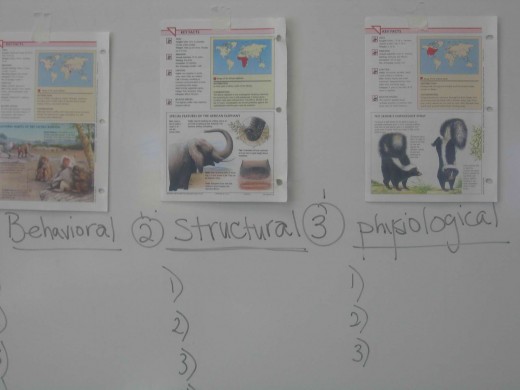Differentiation in the Classroom
Examples in the Classroom


What is differentiation?
Differentiation is the idea of varying a technique or task to recognize differences. For so long people have always seemed to think that there is one way to do things right. However, considering that we are all different individuals, coming from different cultures and backgrounds, we must also consider that a job can be completed in various ways and still be high quality. As a teacher I have learned that differentiation makes learning more intriguing for students. In other careers it sets a stage for various personalities and individual traits. It enables us to appreciate creativity and respect for individual ideas and talent.
In the Classroom
Teachers should use data: test scores, previous reports, and other information in students' individual records to create a chart. This chart should be use to categorize your students based on their needs, ex: Below Level, On Level, Above Level. Knowing your base allows you to appropriately plan your differentiated lesson plan. That way you will not only teach to the middle and hope that everyone will catch on, but you will plan to engage the whole class. A typical lesson will ask close ended questions that everyone is expected to know the answer to. A differentiated lesson will ask open ended questions that will allow for all levels to respond to. Teachers can gauge for opportunities to explain concepts by using student responses.
Preparing for different levels means having an understanding not only of the students' individual needs but also their learning styles. Some children are more apt to sit still and enjoy hearing a brief lecture, while others would rather move around and act out the lesson; for example, a skit about a cycle. Others need pictures to visualize and keep tract of what is being said. Many teachers struggle with differentiation because it intells a surfiet amount of detailed work. Often times various materials and stations have to be set up. Small group lessons have to reflect different objectives based on data. Anecdotal records must be organized and kept for each student, and a general knowledge must be apprehended on each student as well.
How can a teacher effectively teach to different levels and different personalities with yet different learning styles when he or she is but one person? Use workstations, and rotate students through them after a whole group introduction. Make a small group station one of the stations that students rotate through, where they meet up with you and practice or hear something they need to learn individually. In order to do this efficiently, you must make your behavioral expectations clear and have classroom procedures in place to discourage any interruptions in the learning environment.
What are the effective ways to begin teaching with differentiation?
Effective teaching itself involves addressing how developed individual students' are. The easiest way to begin noticing how you differentiate is when you are directly lecturing to your whole group. Before you split kids up in workstations and pull a small group, you first guide the whole group. Now the guidance can be scaffold up or down depending on the needs of the whole group. Start teaching on level first because students have to know the concept on level to meet standards. However as you begin to check for understanding and some students lack on level understanding, scaling the lesson back to fill the gap in the understanding should also occur and likewise for students who completely understand the on level material, they need higher order thinking opportunities throughout the lesson to be challenged. This is not easy and can be challenging if the teacher's prior knowledge on the concept is not fully informed.
One way to prepare for differentiation in whole group is to study the concept in 1-2 prior grades and in 1-2 grades after the grade you are teaching. Knowing the range of ideas that make up the concept allows a teacher to scaffold through the lesson and teach to the middle and fill in gaps and extend learning all in one lesson.
Also embedding routines and resources that are created with differentiation in mind, aids a teacher in meeting so many student needs
Examples:
- placing mini charts, like 100s, multiplication charts or graphic organizers for reading in students desk pockets readily available when they need it.
- Book boxes with students accurate reading level
- creating tailored learning profiles on computer learning programs
- creating different tiered work stations
- having a model pre-done for special needs students to follow if needed
- color coding groups and assigning numbers to students to respect their privacy while effectively grouping them for organization through transitions and small groups.
You can find guidance through your lead teacher or admin team. Often working with colleagues makes the job easier. If you are departmentalized, discuss your shared students with your partner teacher helps in identifying student needs. Also using various curriculums helps. You can take different aspects that might help your students learn. Also talking to parents about differentiation helps set an understanding about how their child's individual academic needs are addressed in the class setting. For example, with homework, send home more than one choice or a modified version will signify that the child's deficit or accommodation is being considered. Recruiting parents support in the differential quest helps to reinforce interventions and progress that meet district requirements to help with large projects.
Helpful links that support differentiation
- Workstations not playstations: A teacher's workstati...
Teachers have to motivate students to learn, by innovating new, creative ways. We have to compete with the entertaining world that captivates students more than ordinary, old fashion methods of teaching. Workstations are centers where children... - Step by Step Fractions
This is a step by step way to teach fractions. Often some kids struggle with all the different aspects. Teachers as well as parents can use visuals as well as everyday examples like eating a pizza to make learning fractions easy. This article also ta - Homeschooling your child: Look at this Option
- How to create a 5 E Lesson Plan
The 5 E lesson plan format is described and explained. - How to Add Large Numbers?
Helpful Books
© 2012 Dominique Broomfield MEd




